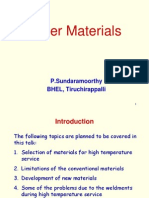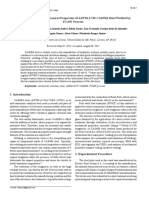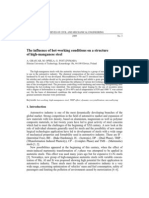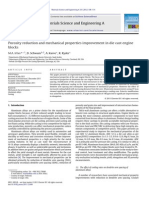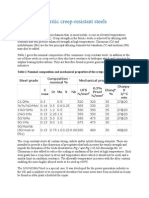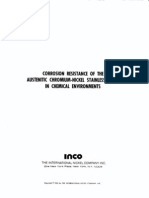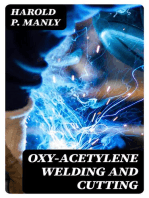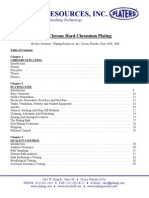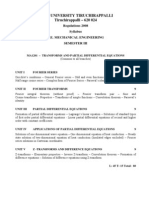Thermit Welding of Chromium Vanadium Railsteel
Thermit Welding of Chromium Vanadium Railsteel
Uploaded by
santu_23Copyright:
Available Formats
Thermit Welding of Chromium Vanadium Railsteel
Thermit Welding of Chromium Vanadium Railsteel
Uploaded by
santu_23Original Description:
Copyright
Available Formats
Share this document
Did you find this document useful?
Is this content inappropriate?
Copyright:
Available Formats
Thermit Welding of Chromium Vanadium Railsteel
Thermit Welding of Chromium Vanadium Railsteel
Uploaded by
santu_23Copyright:
Available Formats
Thermit welding
of chromium-vanadium
rail steel
Thermit welding of chromiumvanadium rail steel
H. D. Fricke (U.S. Thermit Inc.)
Thermit welding techniques are' discussed with particular reference to short preheat cycles and its suitability to the welding of high-strength chromiumvanadium rails. The composition of the Thermit steel used is adjusted to match the phase-transformation characteristics of chromium-vanadium steels. To avoid a martensitic or bainitic structure in the finished weld, the cooling cycle must be controlled.
1. INTRODUCTION
Thermit welding has been applied as a regular welding process since 1898, when the aluminothermic reaction between a metal-oxide and aluminum was discovered by Hans Goldschmidt. This type of reaction is characterized by its exothermic nature. Due to the difference of free energy between a metal-oxide and aluminum-oxide, sufficient heat is generated to produce liquid steel or any other metal and alloy without applying energy from outside. All components for the aluminothermic process are used as granules or powders. Once the reaction is initiated by an external heat source, the aluminum reduces the oxygen from the metaloxide, which will result in a liquid superheated metal and aluminum-oxide (AI203)' Since these two components are different in density, they separate automatically and the liquid metal can be utilized for different welding applications, or just for the production of special metals or alloys. Thermit welding had its most important large-scale technical application during the early parlofthis century as a
process for joining heavy cross-sections for machinery, millhousings, rudderstocks, stern frames and pinions, but the welding of rail sections has become more and more important with the widespread installation of continuous welded rail. While the majority of rail steel is still rolled according to the AREA or VIC specifications, the continuing development towards faster speeds, higher axle loads and increased train frequencies has led to increased requirements for rail steels with improved mechanical properties. The common carbon-manganese rail steels do not satisfactorily withstand these parameters and show gross plastic deformation and abrasive wear after relatively short periods of time. This has led to the development of special alloyed rail steels with higher yield and tensile strength. During the course of development of these alloyed rail steels, one major demand has always been taken into consideration, that is weldability by both the in-plant welding as well as field welding processes such as Thermit welding.
2. RAILSTEELTYPES
Since the time the first alloyed rail sections were rolled by various steel mills, extensive research has been done in our metallurgical laboratories to develop Thermit portions for this new type of rail. The welding parameters had to be changed in order to avoid critical cooling rates in the weld, as well as the adjacent heat-affected rail sections, since, generally speaking, alloyed rail steel has different transformation temperature characteristics which will result in embrittled bainitic or martensitic microstructures where the
Table I. Chemistry of various alloyed rail steels
Chemical Composition Manufacturer A C,% 0.55 to 0.75 0.65 0.65 to 0.80 0.68 to 0.78 0.76 Si,% Max. 0.70 Mn,% 0.80 to 1.30 1.00 0.80 to 1.30 1.10 to 1.40 0.37 Cr,% 0.80 to 1.30 1.00 0.70 to 1.20 1.00 to 1.30 1.49 Mo,% Max. 0.15 V,% Max. 0.30 Max. 0.20 P,% Max. 0.03 Max. 0.03 Max. 0.03 Max. 0.04 S,% Max. 0.03 Max. 0.03 Max. 0.03 Max. 0.03
B C
0.50 0.30 to 0.90 Max. 0.35 0.84
D E
0.02
0.02
63
Vanadium in Rail
Steels
350
NE E
Process:
SI<V
DEFLECTION, 50
in
0.90
'iii
0.3
0.4
0.5
0.6
2
"0
45
300
!:: 2
::i en en w en a: w Q. Q. ::>
40
250
en en w a: 35 In a: w Q. Q.
~ ~ I~ ..J
~ 0.80 1-'
z w
I-
30 ::> 200 '-105 2 4 6 LOAD CYCLES 8 106 2 x 106
Z 0 U 0.70 z 0 III a: <t U 0.60
Fig.1 Fatigue tests of welds made with chromiumvanadium steel profile S54 rails. Test frequency 5.55 sec-1; stress limit (00) calculated from section modulus WxF
0.50
10
12 DEFLECTION,
14 mm
16
cooling rates, after completing a weld, are not sufficiently reduced. Table I demonstrates the chemical composition of five alloyed rail steels from five different manufacturers which, to my knowledge, represent the various types of alloyed rail on the market today. The chemical analyses shown in the Table were taken either from rail samples or reflect a complete range for each element as indicated by the manufacturer. Whereas the approach to develop a rail steel with higher strength and better wear characteristics superior to the carbon-manganese steel varies with each manufacturer, the Thermit portions are formulated for the application to any one of these rail steels. The Thermit test welds with these alloyed rail steels were performed with different procedures, ranging from no preheat at all (Self-preheat process), 1to 2 min preheating (SKV),
Fig.2 Correlation between carbon content and deflection of Thermit welds with an average carbon content of 1.15% (1 m (3.3 ft) span between supports) and 5 to 10 min preheating (SoW). The welds were subjected to various degrees of testing, such as slow bend test, fatigue test, hardness tests as well as to intensive investigations ofthe microstructure.
3. PHYSICAL TEST RESULTS
Fatigue tests were carried out according to the specifications of Deutsche Bundesbahn (DB) and Schweizerische Bundesbahn (SBB). The distance between the two supports was 1200 mm (47.2 in) with a two-point load applied to the weld. The load points were 150 mm (5.9 in) apart. The minimum stress limit was 100 N/mm2 (14.5 ksi), with a test
1000
~.~m
I~
Iv
.
1832
Thermit Steel
800
0
'\.
1\
..\
'm
'Ill
1112 w'
u
w' a: 600
::>
I<t a: w Q. 400 2 w
a: ::> I<t a: w Q. 2 w
I-
200
I- ~Ms
M
I
~i
L
~
~8N3~
1
752
I-
392
'~~~I
10
L-L.J...J
0.1 sec
L...L..I
102
~
103
~
104 102
0.01 min
0.1
1 TIME
10
Fig.3 CCT diagram for Thermit steel, welded on chromium-vanadium steel rail. (Therm it steel composition: C, 0.7%; Si, 0.5%; Mn, 1.2%; AI, 0.35%. Tensile strength: 1100 N/mm2 (160 ksi)) (Taken from H. D. Fricke, H. Gunterman, N. Jacoby, ETR, 4 (1976) pp. 199-208) 64
Thermit welding of chromium-vanadium
rail steel
frequency of 5.5 cycles/sec. Welds were tested up to 2.0 million cycles and in case of no failure, discontinued. Figure 1 shows the Woehler curve which resulted from tests made with SKY welds on chromium-vanadium steel rail sections, profile S54. Slow bend tests showed increased fracture loads of about 10% higher in comparison to carbon-manganese steel welds, but as anticipated somewhat lower deflection. As in the case of welds made with heat-treated carbon-manganese rail steel, the AREA specifications calling for 25.4 mm (1 in) deflection in the commonly known AREA test arrangement, cannot always be met. This can be attributed to the fact that elements such as chromium-vanadium and molybdenum will
increase the strength by refinement of the interlamellar spacing, as well as the precipitation of carbides, but will also result at the same time in a decrease of ductility. Figure 2 shows the correlation between carbon content and deflection of welds made with chromium-alloyed rail steel.
4. TRANSFORMATION CHARACTERISTICS
Figure 3 shows the typical chemistry of a Thermit steel and its corresponding CCT diagram. The steel was austenitized for 30 min at 950C (1742F) resulting in a grain size of ASTM No. 3, which is comparable to the grain size in the
1000
..... Rail Steel U.S.A. 132 Ib/yd (66 kg/m) -
1832
800
1472
Act = 720C
u
w'
~ 400 I200
a: :> I- 600 a: f-w Cl.
IC:M' 100
1.00 V
w' a:
1112.
u..
I'
, \ It
P",
100 l(9100\\I t -1\
transformation Completeferrite/pearlite
~
2 w !-
I
752
a: w Cl.
i-- Ms
1 sec
at 2i\ "nd 20 sec \
M
10
'\
r-,.\
102
\ \ \"
103 10 102
392
104
1 min
TIME Fig.4 CCT diagram for carbon-manganese (AREA) rail steel. (Composition: C, 0.79%; I\1n, 0.88%; Si, 0.11%. Tensile strength: 900 N/mmz (130 ksj)) (Taken from W. Ahlert, ETR, 18 (1969), pp. 468-520)
1000
I -= .--1.
""
u
w a:
800
',
"\
Cr-Mn Alloyed Rail
Steel of Special Grade
(
1
1832
Act'" I 600
I
725C
\.
1472
u.. 0
~ ~ I-
"
A
fi 100.. " Complete
P
a: w Cl.
400
Ferrite/Peal rlite Transformation at 580 C and 220 sec 1112
~
!;t
'\
\"
Commendable 752
a: w
Cl. 2
BMs '\"" 40 M i
I ro..
Cooling Curve \. 392 104 102
200
1 sec
10
I
102
I
103 10
1 min TIME
Fig.5 CCT diagram for 1% chromium steel. (Composition: C, 0.77%; Cr, 1.07%; Mn, 1.06%; Si, 0.39%. Tensile strength: 1080 N/mm2 (157 ksi)) (Taken from W. Ahlert, ETR, 18 (1969), pp. 468-520)
65
Vanadium in Rail Steels
Thermit steel adjacent to the rail. Even though the maximum temperature in a weld is significantly higher, the total time interval during which the weld will remain in this high temperature range is considerably shorter, consequently resulting in the same grain size. A time/temperature curve, taken at the fusion line between the Thermit and the rail steel is plotted in the CCT diagram. It demonstrates that in the area with the highest cooling rate, the microstructure transforms fully into pearlite. This time/temperature curve, shown in Fig. 3, was taken in a weld made with the SKY Thermit welding process, where the rail ends were preheated for 2 min. Welds made with the SoW Thermit welding process, which requires a longer preheating time of up to 10 min, naturally resulted in slower, even less critical cooling rates. The time/temperature curve of a weld made with the self-preheat (SPH) Thermit process with no external preheat, is almost identical to the one measured with the SKY process. This process is accomplished through a different weld design as well as a different
flow and larger amount of the liquid steel, where one-third of it is used only for the purpose of preheating and washing the rail ends. Furthermore, it should be mentioned that the chemical analysis of welds made with the SPH process is different, with higher silicon and lower manganese content. This higher Si content of up to 1.5%is due to the different raw materials used for the manufacture ofthe molds, where the Si is absorbed by the liquid Thermit steel from the mold. Figures 4 and 5 show the CCT diagram for a regular AREA carbon-manganese steel and for a 1% chromium rail steel. Other diagrams for the different variations as shown in Table I, have been published in several papers. The CCT diagram for a 1% chromium steel demonstrates that for a temperature range from 800C (1472F) to 500C (932F), at least 200 sec are required for fully pearlitic transformations, whereas the same temperature interval for a regular carbonmanganese"steel, according to AREA specifications, might be crossed within 50 sec.
Temperature, 800-400 C
1 cm (0.39 inl
1400
(1472-752 F)
1... 2... 3...
-
?
w 0::
::>
1000
1\CJ \
: I
.
ci?
Standard practice, maid top removed Maid top removed, wrapped with insulation Full maid removed, air jet applied
23min 37 min 6.3min
u..
2192
,\,\
I-
111
"\:- \.
\\
--".:::::
w
1472
<I: et w 1- 600
ii
:2 w
I,
--- --- ----------"""""'
........... 1
~ I:2 w
<I: 0:: w
12
752
I-
200
' 3
0 Fig.6 Thermal
10
20
30 40 TIME, min welds cooled by different
50 methods 1832
cycles of SKY Thermit
1000 0 800
Key
X SKVweld
Self-preheat (SPH) weld 1472
u 0
w 0::
.. f
I I 1112
u..
0
w ~ I<I: 0:: w 1:2 w I-
~ <I: 600
0:: w 1:2 w
3cm
752
I-
400
200
I I I I I I I I
4 8 12 THinE,min
t:J9
16 20
392
Fig.7 Temperature/time curves for SKY and SPH welds 3 cm (1.18 in) from end of rail
66
---
-------
Thermit welding of chromium-vanadium
rail steel
A comparison between Figs. 3 and 5 shows that control ofthe cooling rate is most important in the heat-affected zone of the rail steel where precautionary steps have to be taken in order to avoid embrittled microstructures. This is most important with the preheated types of Thermit welds, where the excess weld metal, the so-called riser on top of the rail
head will be removed either by hot chiselling or shearing after solidification of the weld. Immediately thereafter, the sheared off upper part of the mold containing hot steel and slag should either be placed back on to the top of the weld or the weld, as well as the adjacent rail sections, should be covered with an insulating blanket. Furthermore, head and base of the rail on both sides of the mold-half should be evenly post heated for approximately 2 min. Figure 6 shows three thermal cycles of SKV welds, cooled by different methods. Optimum results are accomplished by wrapping the weld with an insulating blanket after the excess metal has been removed. If the SPH process is applied for Thermit welding, the head riser does not have to be removed until the weld cools to approximately lOOC (2lOF) or less. Until that time the mold remains in place and will protect the weld and heat-affected zone from cooling too fast. Insulating blankets are not required, as the wide mold halves overlap the weld and rail section on both sides by 9.5 cm (3.74 in). However, in order to build up a heat wall and prevent the rail sections from cooling too fast, a postheating treatment should be applied in the same manner as that recommended for the SKV and SoW processes. Figure 7 shows the cooling curve of a Thermit weld made with the SPH process, where the molds remained in position for the entire cooling period.
~. THERMALTRANSFORMATION OF THE RAIL STEEL
Depending upon the gap size between the two rail sections to be welded as well as the total preheating time, the width of the heat-affected zone is developed differently. Figures 8, 9 and lO show some macro-etched cross-sections which are characteristic for each process. The total width of the heat-affected zone is bordered by the two light vertical lines, where pearlite has been spheroidized but not as yet austenitized- Figure 11 shows the microstructure in the transition zone from the weld to the heat-affected rail steel.
Fig- 8 Macroetched cross-section of a SPH weld
Fig.9 Macroetched cross-section of a SKV weld 67
Vanadium in Rail Steels
Fig.10 Macroetched cross-section of a SoW weld
Fig.11 Microstructure of the transition zone between rail and Thermit steel X100
I Welding Method
I
Preheat!ng Time 5min 2min "
f
"
0 M
> 400 J: IX: W aI ~ 350 :> 2
Cl) Cl) w is 300 IX: <t J: 250
.A --"-
. .-- - Se.." SPH
Cr-Mn Alloyed Steel Rail Head
KV~F
~..
\,,(
~/
.
\
\ "' ..-"-~." 6" .,.:
"
.\
'. /.'. \
'
0 M
400 >
"',
. . ~'.,'~ .,." '. \ .. "
"
I /J "-"'.\ i '. '
I
I
E
IX: w aI
'..' \.
..i
v, I i . / .'''''-.1 \ - r;' :. \,i;
,.
"
..
A,
"
\" ! \ '--1 1\ I "-.. \
'
. ,\,...~
\ 'A.A" ~ ..
.
... \ io.--. \ .',1. /\ I / \ ,. \
I
\
. I',
\.. .,'-.
'.- /
\: I
-~,!
"I i
,.,
I "
".
..
,
\: "
" ~ \ I '.-'-'\ I \'
'\'.
I, . .~, \ .--.
I
; \,/ \
\ .
SPH SoW SKV-F
16 12
\" ,/ - V ;/
HAZ Thermit Weld HAZ ~
..
Fig.12 Hardness distribution in the 350 :i: weld and adjacent rail section for :> SPH, SKY and SoW welds. {Tensile 2 Cl) strength: 1080 N/mm2 (157 ksi)) Cl) w (U.S. Thermit Corp./Th.G.AG, 1979)
300 i5 IX: <t J:
250
12
16
DISTANCE
FROM CENTER OF THERMiT
WELD, cm
68
Thermit welding of chromium-vanadium
rail steel
metallurgical standpoint is to be considered as a casting, this difference in hardness will balance itself out as soon as the rail is exposed to regular train service, and the rail and the Thermit steel will eventually have the same end hardness. The most heat-affected zone of the rail, next to the fusion line with the weld, having a maximum grain growth of the austenite, shows the highest peak in hardness, whereas the spheroidized pearlite results in the area of lowest hardness. 7. SPECIAL PRECAUTION WHEN WELDING ALLOYED RAIL STEEL Despite the fact that all types of alloyed rail steel with chemistries such as those indicated in Table I show very good weldability characteristics for the different Thermit welding processes, there are some points that require special attention. 7.1 Hot shearing If the excess metal on top of the head is removed by shearing, the waiting time between the pouring of the Thermit into the mold and the start of the shearing operation, should be longer than normal if a single blade type shear is used. If the waiting time is not long enough, it will result in hot tearing in the center of the weld (Fig. 13). This can be eliminated by applying the double blade shear in which two blades shear the weld from opposite sides. Furthermore, tests have shown that the tendency for hot tearing will be lessened with shorter preheating periods. 7.2 Torch cutting If torch cutting is necessary, which will be the case whenever no abrasive saw is available, and the rail ends have to be cut for preparation of the gap for Thermit welding, the rail ends must be preheated according to the instructions of the different rail manufacturers. The preheating temperature should be 500-600C (930-111OaF)for at least 0.2 cm (0.08 in) on both sides of the projected torch cut, and approximately 50C (120F) at a distance 1.0 m (approx. 3 ft) on both sides. If the Thermit weld is not to be made immediately, the rail sections have to be preheated for another 5 min at a temperature of approximately 500C (930F). Arc welding cannot be performed without preheating to 5000~600C (930-11 10F), and this temperature should be maintained during the whole welding operation.
Fig.13
Hot tearing after shearing Thermit steel too early
6. HARDNESS
The heat pattern as shown in Figs. 8 to 10 is reflected in the hardness profiles taken in the head parallel to the running surface, see Fig. 12.The hardness of the weld is slightly higher than that of the unaffected rail steel. As the rolled steel has a tendency to work-harden more than the weld, which from a
DISCUSSION
ON
Thermit welding of chromiumvanadium rail steel
H. D. Fricke
F. B. FLETCHER (Climax Molybdenum) I would like to take issue with one statement you made in your presentation: You attribute the smaller deflections you observe in alloy steels to a decrease in ductility ofthe steel due to alloying. We find that, in general, one cannot conclude that the addition of chromium, vanadium, and molybdenum decreases the ductility. In fact, the tensile ductility of steel is not necessarily adversely affected by the addition of these alloying elements. The explanation for the apparent decrease in deflection you observe for alloy steels lies in the fact that there is a measurably greater degree of local deformation under the loading points in the softer unalloyed steels. The alloy steels
do not deform under the loading points as much as the carbon manganese steels, so they appear to give smaller deflections. H. D. FRICKEEven though the weld is called a weld, it is basically a casting, and that should also make a contribution to the ductility we measured. S. MARICH (BHP Melbourne Research Labs) Is there an optimum hardness of the weld metal relative to that of the rail? H. D. FRICKE Our experience has been that the rail steel work hardens faster than the weld metal and eventually, after a certain gross tonnage has passed over the joint, we end up with the same hardness in the rail as in the weld. To take this into account, the weld should, as a general rule, be about 20 points Brinell harder than the rail initially. I must emphasize, though, that this experience is based on carbon-manganese rails. The same situation may not hold in alloy rails and welds, where contributions of the various alloying elements make the situation much more complex.
69
Produced by Mid-County Press, 2a Merivale Road, London SW15
You might also like
- 2.materials Technology Answered PDFDocument4 pages2.materials Technology Answered PDFOxbown9171% (7)
- Class Programme: Type ApprovalDocument21 pagesClass Programme: Type ApprovalShih-Bou Wang100% (1)
- Heat-Treatment of High Carbon Steel Wire - PatentingDocument4 pagesHeat-Treatment of High Carbon Steel Wire - Patentingعزت عبد المنعم100% (1)
- Overheated and Burnt SteelDocument10 pagesOverheated and Burnt SteelBhavikRawalNo ratings yet
- High Entropy AlloysDocument24 pagesHigh Entropy AlloysDevangGandhi7100% (1)
- Maleable Cast IronsDocument0 pagesMaleable Cast IronsGilang Miky Pratama AlwianNo ratings yet
- Welding TMCP SteelsDocument7 pagesWelding TMCP SteelsElias Kapa100% (1)
- AVESTA How To Weld Duplex SteelDocument20 pagesAVESTA How To Weld Duplex SteelGMacella100% (1)
- Effect of Heat Treatment On Microstructures and Mechanical Prop of Spring SteelDocument7 pagesEffect of Heat Treatment On Microstructures and Mechanical Prop of Spring SteelMahmood KhanNo ratings yet
- Austentite Steel Thermal StabilizationDocument17 pagesAustentite Steel Thermal StabilizationArangamar KumaranNo ratings yet
- Anodic Behaviour of Supermartensitic Stainless Steel WeldmentsDocument5 pagesAnodic Behaviour of Supermartensitic Stainless Steel WeldmentsC_rovereNo ratings yet
- Effect of Alloying Elements On Thermal Wear 2006 Journal of Iron and Steel RDocument7 pagesEffect of Alloying Elements On Thermal Wear 2006 Journal of Iron and Steel RJesus ZilchNo ratings yet
- Analysis of Tig Welding Weldment and Defect Identification Using Non Destructive Testing NDTDocument48 pagesAnalysis of Tig Welding Weldment and Defect Identification Using Non Destructive Testing NDTRebecca KelleyNo ratings yet
- Boiler MaterialsDocument47 pagesBoiler MaterialsSaptarshi Sengupta100% (1)
- CA 6NM CastingsDocument11 pagesCA 6NM CastingsvasanthiNo ratings yet
- Static Strength of Aluminium To Steel Thin Welded Joints Preliminary ResultsDocument2 pagesStatic Strength of Aluminium To Steel Thin Welded Joints Preliminary Results江宸宸No ratings yet
- f6nm PDFDocument5 pagesf6nm PDFasprclms durgapur100% (1)
- Art:10.1007/s11665 008 9336 Z PDFDocument7 pagesArt:10.1007/s11665 008 9336 Z PDFJosé AntonioNo ratings yet
- Exothermic Welding: HistoryDocument3 pagesExothermic Welding: HistoryPratap VeerNo ratings yet
- Bainite in SteelDocument12 pagesBainite in Steelsathyadevi konnurNo ratings yet
- The Welding of Structural Steels Without PreheatDocument10 pagesThe Welding of Structural Steels Without PreheatHouman HatamianNo ratings yet
- IntroDocument9 pagesIntroKeyshia KoishiNo ratings yet
- 4 Harden AbilityDocument12 pages4 Harden AbilityFadlin QisthiNo ratings yet
- Welding of Copper and Its AlloysDocument30 pagesWelding of Copper and Its Alloysaj87_goswami100% (2)
- P91 MaterialDocument15 pagesP91 MaterialelrajilNo ratings yet
- GMAW of Creep Resistant SteelsDocument5 pagesGMAW of Creep Resistant SteelsJustin Morse100% (1)
- The Hot Workability of Croma NiteDocument9 pagesThe Hot Workability of Croma NiteRajan NPNo ratings yet
- TMCP Steels and Their Welding 12342Document16 pagesTMCP Steels and Their Welding 12342claude.bouillot3566100% (1)
- Jominy Experiment ReportDocument13 pagesJominy Experiment Reportsinabirecik0% (1)
- Microstructure and Mechanical Properties of ASTM A743 CA6NM Steel Welded by FCAW ProcessDocument8 pagesMicrostructure and Mechanical Properties of ASTM A743 CA6NM Steel Welded by FCAW ProcessretrogradesNo ratings yet
- Investigation and Application of High Strength Low Alloy Wear Resistant Cast SteelDocument4 pagesInvestigation and Application of High Strength Low Alloy Wear Resistant Cast Steelz2aliNo ratings yet
- Thermite Welding MetallurgyDocument3 pagesThermite Welding MetallurgyDarryl007No ratings yet
- Microstructures and Fatigue Crack Growth of EH36 TMCP Steel WeldmentsDocument8 pagesMicrostructures and Fatigue Crack Growth of EH36 TMCP Steel WeldmentsJohan Esteban Garcia PuentesNo ratings yet
- The Influence of Hot-Working Conditions On A Structure of High-Manganese SteelDocument10 pagesThe Influence of Hot-Working Conditions On A Structure of High-Manganese SteelPiranha TourniquetNo ratings yet
- Porosity Reduction and Mechanical Properties Improvement in Die Cast Engine Blocks (Pub Year) Materials Science and Engineering ADocument7 pagesPorosity Reduction and Mechanical Properties Improvement in Die Cast Engine Blocks (Pub Year) Materials Science and Engineering AgiokniessNo ratings yet
- DCSP Tig Welding of Aa2219 Aluminum AlloyDocument14 pagesDCSP Tig Welding of Aa2219 Aluminum AlloySgk ManikandanNo ratings yet
- Jominy End Quench Hardenability Test: Tejas AtyamDocument15 pagesJominy End Quench Hardenability Test: Tejas AtyamNaisarg ChauhanNo ratings yet
- Welding of Ferritic CreepDocument3 pagesWelding of Ferritic CreepMuhammed SulfeekNo ratings yet
- Crrep of Copper Alloys PDFDocument12 pagesCrrep of Copper Alloys PDFValentin CedilloNo ratings yet
- Metallurgical Studies of Quench-and-Self-Tempered-Produced RebarDocument12 pagesMetallurgical Studies of Quench-and-Self-Tempered-Produced RebarJerry WangNo ratings yet
- High Strength SteelDocument19 pagesHigh Strength SteelBHARANINo ratings yet
- Welding of Austenitic Stainless Steel - Part 2 - TWIDocument6 pagesWelding of Austenitic Stainless Steel - Part 2 - TWISumantaNo ratings yet
- Boiler Tube GradesDocument12 pagesBoiler Tube Gradesfelram100% (1)
- CMA-106H PF-500/US-521H Tgs-2Cmh: Technical ReportDocument5 pagesCMA-106H PF-500/US-521H Tgs-2Cmh: Technical ReportAshishNo ratings yet
- Properties and Welding Procedure For Grade 91 Alloy Steel: Siddharth Pant and Swati BhardwajDocument6 pagesProperties and Welding Procedure For Grade 91 Alloy Steel: Siddharth Pant and Swati BhardwajArvind ShuklaNo ratings yet
- O HC HCDocument101 pagesO HC HCIndustrial Infra Jobs100% (1)
- Creep and Creep Damage Assessment in P91 Weld JointsDocument12 pagesCreep and Creep Damage Assessment in P91 Weld JointsDeepakNo ratings yet
- Maraging Steel - WikipediaDocument5 pagesMaraging Steel - WikipediaVysakh VasudevanNo ratings yet
- Performance Optimization of High Resistant White Cast Iron For Severe Working ApplicationsDocument6 pagesPerformance Optimization of High Resistant White Cast Iron For Severe Working ApplicationsANA LAURA BRAGA NASCIMENTONo ratings yet
- InTech-Welding of Aluminum Alloys PDFDocument25 pagesInTech-Welding of Aluminum Alloys PDFCortesar ManuNo ratings yet
- Whisker Free Tin Jan Feb White Paper DownloadDocument6 pagesWhisker Free Tin Jan Feb White Paper DownloadRajashekhar MahantinamathNo ratings yet
- Advance Vanadium Modified Steels For High Pressure Hydrogen ReactorsDocument7 pagesAdvance Vanadium Modified Steels For High Pressure Hydrogen ReactorsMatthieuNo ratings yet
- Corrosion Guide - Stainless Internation NickelDocument20 pagesCorrosion Guide - Stainless Internation NickelJohn BurkeNo ratings yet
- Material Science 1 Assignment 2Document4 pagesMaterial Science 1 Assignment 2Mehul BansalNo ratings yet
- TGN PE 01 Hardness Testing of WeldsDocument7 pagesTGN PE 01 Hardness Testing of WeldsadelNo ratings yet
- DOI: 10.1515/amm-2016-0198Document8 pagesDOI: 10.1515/amm-2016-0198BHARANINo ratings yet
- The Working of Steel: Annealing, Heat Treating and Hardening of Carbon and Alloy SteelFrom EverandThe Working of Steel: Annealing, Heat Treating and Hardening of Carbon and Alloy SteelNo ratings yet
- The Working of Steel Annealing, Heat Treating and Hardening of Carbon and Alloy SteelFrom EverandThe Working of Steel Annealing, Heat Treating and Hardening of Carbon and Alloy SteelRating: 5 out of 5 stars5/5 (4)
- Oxy-Acetylene Welding and Cutting: Electric, Forge and Thermit Welding together with related methods and materials used in metal working and the oxygen process for removal of carbonFrom EverandOxy-Acetylene Welding and Cutting: Electric, Forge and Thermit Welding together with related methods and materials used in metal working and the oxygen process for removal of carbonNo ratings yet
- Sexton's Pocket-Book for Boiler-Makers and Steam Users: Comprising a Variety of Useful Information for Employer and Workmen, Government Inspectors, Board of Trade Surveyors, Engineers in Charge of Works and Ships, Foreman of Manufactories, and the General Steam-Using PublicFrom EverandSexton's Pocket-Book for Boiler-Makers and Steam Users: Comprising a Variety of Useful Information for Employer and Workmen, Government Inspectors, Board of Trade Surveyors, Engineers in Charge of Works and Ships, Foreman of Manufactories, and the General Steam-Using PublicNo ratings yet
- CCM Vickers Key Comparison Final Report: Physikalisch-Technische Bundesanstalt BraunschweigDocument54 pagesCCM Vickers Key Comparison Final Report: Physikalisch-Technische Bundesanstalt Braunschweigsantu_23No ratings yet
- Hellenic Accreditation System: Annex F1/12 To The Certificate No. 124-5Document4 pagesHellenic Accreditation System: Annex F1/12 To The Certificate No. 124-5santu_23No ratings yet
- Maximator Test BenchesDocument16 pagesMaximator Test Benchessantu_23No ratings yet
- ISO 4016-2001 DIN en ISO 4016-2001 - Hexagon Head BoltsDocument13 pagesISO 4016-2001 DIN en ISO 4016-2001 - Hexagon Head Boltssantu_23No ratings yet
- Dac CurveDocument24 pagesDac Curvesantu_23No ratings yet
- Durachrome Hard Chromium Plating: Surface Finishing TechnologyDocument40 pagesDurachrome Hard Chromium Plating: Surface Finishing Technologysharmakritya1895100% (4)
- Guide To Fillet WeldingDocument7 pagesGuide To Fillet WeldingPeter KyawNo ratings yet
- Calcined CokeDocument10 pagesCalcined Cokesantu_23No ratings yet
- Papillon (NASA)Document49 pagesPapillon (NASA)Guna SGNo ratings yet
- Alloy 6022 Sheet: Higher Strength With Improved FormabilityDocument6 pagesAlloy 6022 Sheet: Higher Strength With Improved Formabilitywulfgang66No ratings yet
- ASME Weld Number Tables - P Number Base & F Number FillerDocument14 pagesASME Weld Number Tables - P Number Base & F Number FillerChris McNairNo ratings yet
- What Is Term Applied To The Process of Separating Different Sizes of The Same Material? A. Screening D. FilteringDocument99 pagesWhat Is Term Applied To The Process of Separating Different Sizes of The Same Material? A. Screening D. FilteringJom BautistaNo ratings yet
- Arcos High Nickel BrochureDocument24 pagesArcos High Nickel BrochureJuan RodriguezNo ratings yet
- Corrosion by Sulphur: 8.4 Sulphidation in H /H SDocument1 pageCorrosion by Sulphur: 8.4 Sulphidation in H /H SBrayan UribeNo ratings yet
- Duplex Steel (CD-4MCu)Document8 pagesDuplex Steel (CD-4MCu)Anonymous CMS3dL1TNo ratings yet
- 9 Strip Casting Technology PYMenetDocument5 pages9 Strip Casting Technology PYMenetNikolas Kolasni Lakenir Ckerde DockosNo ratings yet
- Laser Beam Scanning PatternsDocument11 pagesLaser Beam Scanning PatternsMassab JunaidNo ratings yet
- Airbus Specification Nadcap Commodity CrossTableDocument21 pagesAirbus Specification Nadcap Commodity CrossTablekishan revankarNo ratings yet
- Visual Inspection For AircraftDocument248 pagesVisual Inspection For AircraftOz2iaZ100% (1)
- Sem and XRD Study of Fe CR C HardfacingDocument8 pagesSem and XRD Study of Fe CR C HardfacingsainivijayNo ratings yet
- BS 2897-1970Document12 pagesBS 2897-1970thdtmdgh0805No ratings yet
- Non Ferrous MaterialsDocument8 pagesNon Ferrous MaterialsSH1961No ratings yet
- bs-2151 - SpecDocument2 pagesbs-2151 - SpecOmar J Humerez M100% (1)
- A020 PDFDocument32 pagesA020 PDFsolrac4371No ratings yet
- ASTM A681-08 - Standard Specification For Tool Steels AlloyDocument14 pagesASTM A681-08 - Standard Specification For Tool Steels Alloyhand42100% (1)
- S 181Document9 pagesS 181Wisnhu PamungkasNo ratings yet
- Anna University Tiruchirappalli Tiruchirappalli - 620 024Document22 pagesAnna University Tiruchirappalli Tiruchirappalli - 620 024Azaath AzuNo ratings yet
- Effect of 0.5Wt% CR Addition On The Mechanical Properties and Microstructure of Heat Treated Plain Carbon Low Alloy SteelDocument5 pagesEffect of 0.5Wt% CR Addition On The Mechanical Properties and Microstructure of Heat Treated Plain Carbon Low Alloy SteelhburitiNo ratings yet
- Texroll Catalogo IngleseDocument24 pagesTexroll Catalogo IngleseDiego Fernando AVENDA¥O RODRIGUEZNo ratings yet
- Development and Application of Nickel Alloys in Aerospace Engineering PDFDocument9 pagesDevelopment and Application of Nickel Alloys in Aerospace Engineering PDFAditya Budi FauziNo ratings yet
- Astm E112 12Document10 pagesAstm E112 12jean carlo souzaNo ratings yet
- Alligation and Mixture (Aptitude)Document9 pagesAlligation and Mixture (Aptitude)Anonymous ZVbwfcNo ratings yet
- Machine Tools Cutting FluidsDocument133 pagesMachine Tools Cutting FluidsDamodara MadhukarNo ratings yet
- Cdsa 02Document8 pagesCdsa 02montsegranNo ratings yet
- Aluminum Welding Techniques: Tel. Mobile: E-MailDocument35 pagesAluminum Welding Techniques: Tel. Mobile: E-MailMo TanamNo ratings yet













